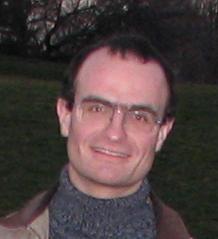Lukas Kroc: Difference between revisions
From Santa Fe Institute Events Wiki
Lukas.kroc (talk | contribs) No edit summary |
Lukas.kroc (talk | contribs) No edit summary |
||
| (2 intermediate revisions by the same user not shown) | |||
| Line 1: | Line 1: | ||
[[Image:lukas.jpg]] | |||
I am a PhD student in Computer Science at Cornell University. My academic interests are in the area of boolean problem satisfiability. This particular subfield of Artificial Intelligence shares problems with seemingly unrelated fields such as Statistical Mechanics and Information Theory, which makes it possible to apply techniques developed in one field in another. This often involves working with systems of many simple elements connected in a way that results in a complex and hard-to-understand behavior. | I am a PhD student in Computer Science at Cornell University. My academic interests are in the area of boolean problem satisfiability. This particular subfield of Artificial Intelligence shares problems with seemingly unrelated fields such as Statistical Mechanics and Information Theory, which makes it possible to apply techniques developed in one field in another. This often involves working with systems of many simple elements connected in a way that results in a complex and hard-to-understand behavior. | ||
I am also a big fan of New Mexico and Santa Fe area in particular, so I hope to be able to make some trips around during the summer :-) . | I am also a big fan of New Mexico and Santa Fe area in particular, so I hope to be able to make some trips around during the summer :-) . | ||
'''Discussion Questions:''' | |||
''1. What topics do you have some expertise in and would you be willing | |||
to help others learn them?'' | |||
Markov Chain Monte Carlo, local search problem solving techniques. | |||
''2. What do you want to learn?'' | |||
Ideas and approaches to working with complex systems from a range of fields. Formal treatment and description of such systems. Look for connections and similarities of the above in different disciplines. | |||
''3. Do you have any projects that would benefit from interdisciplinary approach?'' | |||
Boolean constraint satisfaction: trying to satisfy a set of entities (clauses in this case) with competing needs (variable settings). An approach inspired by Statistical Mechanics has recently been found very powerful in solving (a certain subclass of) such problems. There might be other relevant ideas in other fields tackling this very general problem. | |||
''4. Do you have any ideas for what sort of project you would like to | |||
attack this summer?'' | |||
Survey Propagation study, the approach to solving constraint satisfaction problems inspired by Statistical Mechanics, mentioned in the previous bullet. | |||
''6. If you were given the opportunity to see where we were in one | |||
hundred years with respect to progress on one problem/subject, what | |||
would it be?'' | |||
Elementary Particle Physics, structure and nature of "time" and "space" and their interplay. In popular-science form, of course :-) | |||
Latest revision as of 15:20, 28 May 2006
I am a PhD student in Computer Science at Cornell University. My academic interests are in the area of boolean problem satisfiability. This particular subfield of Artificial Intelligence shares problems with seemingly unrelated fields such as Statistical Mechanics and Information Theory, which makes it possible to apply techniques developed in one field in another. This often involves working with systems of many simple elements connected in a way that results in a complex and hard-to-understand behavior.
I am also a big fan of New Mexico and Santa Fe area in particular, so I hope to be able to make some trips around during the summer :-) .
Discussion Questions:
1. What topics do you have some expertise in and would you be willing to help others learn them?
Markov Chain Monte Carlo, local search problem solving techniques.
2. What do you want to learn?
Ideas and approaches to working with complex systems from a range of fields. Formal treatment and description of such systems. Look for connections and similarities of the above in different disciplines.
3. Do you have any projects that would benefit from interdisciplinary approach?
Boolean constraint satisfaction: trying to satisfy a set of entities (clauses in this case) with competing needs (variable settings). An approach inspired by Statistical Mechanics has recently been found very powerful in solving (a certain subclass of) such problems. There might be other relevant ideas in other fields tackling this very general problem.
4. Do you have any ideas for what sort of project you would like to attack this summer?
Survey Propagation study, the approach to solving constraint satisfaction problems inspired by Statistical Mechanics, mentioned in the previous bullet.
6. If you were given the opportunity to see where we were in one hundred years with respect to progress on one problem/subject, what would it be?
Elementary Particle Physics, structure and nature of "time" and "space" and their interplay. In popular-science form, of course :-)

